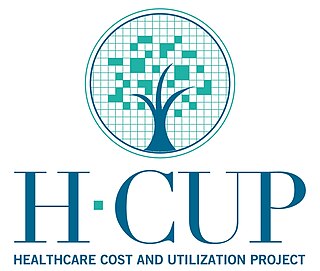Related Research Articles
Outpatient commitment—also called assisted outpatient treatment (AOT) or community treatment orders (CTO)—refers to a civil court procedure wherein a legal process orders an individual diagnosed with a severe mental disorder to adhere to an outpatient treatment plan designed to prevent further deterioration or recurrence that is harmful to themselves or others.

An emergency department (ED), also known as an accident and emergency department (A&E), emergency room (ER), emergency ward (EW) or casualty department, is a medical treatment facility specializing in emergency medicine, the acute care of patients who present without prior appointment; either by their own means or by that of an ambulance. The emergency department is usually found in a hospital or other primary care center.
Length of stay (LOS) is the duration of a single episode of hospitalization. Inpatient days are calculated by subtracting day of admission from day of discharge.

The American Medical Association (AMA) is a professional association and lobbying group of physicians and medical students. Founded in 1847, it is headquartered in Chicago, Illinois. Membership was 271,660 in 2022.

In a physical examination, medical examination, or clinical examination, a medical practitioner examines a patient for any possible medical signs or symptoms of a medical condition. It generally consists of a series of questions about the patient's medical history followed by an examination based on the reported symptoms. Together, the medical history and the physical examination help to determine a diagnosis and devise the treatment plan. These data then become part of the medical record.
A medical error is a preventable adverse effect of care ("iatrogenesis"), whether or not it is evident or harmful to the patient. This might include an inaccurate or incomplete diagnosis or treatment of a disease, injury, syndrome, behavior, infection, or other ailment.
Hospital medicine is a medical specialty that exists in some countries as a branch of family medicine or internal medicine, dealing with the care of acutely ill hospitalized patients. Physicians whose primary professional focus is caring for hospitalized patients only while they are in the hospital are called hospitalists. Originating in the United States, this type of medical practice has extended into Australia and Canada. The vast majority of physicians who refer to themselves as hospitalists focus their practice upon hospitalized patients. Hospitalists are not necessarily required to have separate board certification in hospital medicine.
Futile medical care is the continued provision of medical care or treatment to a patient when there is no reasonable hope of a cure or benefit.

A primary care physician (PCP) is a physician who provides both the first contact for a person with an undiagnosed health concern as well as continuing care of varied medical conditions, not limited by cause, organ system, or diagnosis. The term is primarily used in the United States. In the past, the equivalent term was 'general practitioner' in the US; however in the United Kingdom and other countries the term general practitioner is still used.
Home health nursing is a nursing specialty in which nurses provide multidimensional home care to patients of all ages. Home health care is a cost efficient way to deliver quality care in the convenience of the client's home. Home health nurses create care plans to achieve goals based on the client's diagnosis. These plans can include preventive, therapeutic, and rehabilitative actions. Home health nurses also supervise certified nursing assistants. The professional nursing organization for home health nurses is the Home Healthcare Nurses Association (HHNA). Home health care is intended for clients that are well enough to be discharged home, but still require skilled nursing personnel to assess, initiate and oversee nursing interventions.
Patient safety is a discipline that emphasizes safety in health care through the prevention, reduction, reporting and analysis of error and other types of unnecessary harm that often lead to adverse patient events. The frequency and magnitude of avoidable adverse events, often known as patient safety incidents, experienced by patients was not well known until the 1990s, when multiple countries reported significant numbers of patients harmed and killed by medical errors. Recognizing that healthcare errors impact 1 in every 10 patients around the world, the World Health Organization (WHO) calls patient safety an endemic concern. Indeed, patient safety has emerged as a distinct healthcare discipline supported by an immature yet developing scientific framework. There is a significant transdisciplinary body of theoretical and research literature that informs the science of patient safety with mobile health apps being a growing area of research.

Patient dumping or homeless dumping is the practice of hospitals and emergency services inappropriately releasing homeless or indigent patients to public hospitals or on the streets instead of placing them with a homeless shelter or retaining them, especially when they may require expensive medical care with minimal government reimbursement from Medicaid or Medicare. The term homeless dumping has been used since the late 19th century and resurfaced throughout the 20th century alongside legislation and policy changes aimed at addressing the issue. Studies of the issue have indicated mixed results from the United States' policy interventions and have proposed varying ideas to remedy the problem.
Transitional care refers to the coordination and continuity of health care during a movement from one healthcare setting to either another or to home, called care transition, between health care practitioners and settings as their condition and care needs change during the course of a chronic or acute illness. Older adults who suffer from a variety of health conditions often need health care services in different settings to meet their many needs. For young people the focus is on moving successfully from child to adult health services.
The United States Preventive Services Task Force (USPSTF) is "an independent panel of experts in primary care and prevention that systematically reviews the evidence of effectiveness and develops recommendations for clinical preventive services". The task force, a volunteer panel of primary care clinicians with methodology experience including epidemiology, biostatistics, health services research, decision sciences, and health economics, is funded, staffed, and appointed by the U.S. Department of Health and Human Services' Agency for Healthcare Research and Quality.

The Society of Hospital Medicine (SHM) is a membership society for hospitalists, physicians, and other caregivers who practice the specialty of hospital medicine.

The Healthcare Cost and Utilization Project is a family of healthcare databases and related software tools and products from the United States that is developed through a Federal-State-Industry partnership and sponsored by the Agency for Healthcare Research and Quality (AHRQ).
Bundled payment is the reimbursement of health care providers "on the basis of expected costs for clinically-defined episodes of care." It has been described as "a middle ground" between fee-for-service reimbursement and capitation, given that risk is shared between payer and provider. Bundled payments have been proposed in the health care reform debate in the United States as a strategy for reducing health care costs, especially during the Obama administration (2009–2016). Commercial payers have shown interest in bundled payments in order to reduce costs. In 2012, it was estimated that approximately one-third of the United States healthcare reimbursement used bundled methodology.
A hospital readmission is an episode when a patient who had been discharged from a hospital is admitted again within a specified time interval. Readmission rates have increasingly been used as an outcome measure in health services research and as a quality benchmark for health systems. Generally, higher readmission rate indicates ineffectiveness of treatment during past hospitalizations. Hospital readmission rates were formally included in reimbursement decisions for the Centers for Medicare and Medicaid Services (CMS) as part of the Patient Protection and Affordable Care Act (ACA) of 2010, which penalizes health systems with higher than expected readmission rates through the Hospital Readmission Reduction Program. Since the inception of this penalty, there have been other programs that have been introduced, with the aim to decrease hospital readmission. The Community Based Care Transition Program, Independence At Home Demonstration Program, and Bundled Payments for Care Improvement Initiative are all examples of these programs. While many time frames have been used historically, the most common time frame is within 30 days of discharge, and this is what CMS uses.
Health care efficiency is a comparison of delivery system outputs, such as physician visits, relative value units, or health outcomes, with inputs like cost, time, or material. Efficiency can be reported then as a ratio of outputs to inputs or a comparison to optimal productivity using stochastic frontier analysis or data envelopment analysis. An alternative approach is to look at latency times and delay times between a care order and completion of work, and stated accomplishment in relation to estimated effort.
Karina W. Davidson is senior vice president of research, dean of academic affairs, and head of the center focused on behavioral and cardiovascular health research at Northwell Health She was previously vice-dean of organizational effectiveness and executive director of the Center for Behavioral Cardiovascular Health at Columbia University Medical Center. She was also Chief Academic Officer at NewYork-Presbyterian Hospital in New York City.
References
- ↑ Alfandre, D. "I'm going home": discharges against medical advice. Mayo Clin Proc. 2009 Mar;84(3):255-60.
- ↑ Nurse's Legal Handbook. Lippincott Williams & Wilkins. 2004. ISBN 978-1582552804.
- ↑ Miller, Robert (2006). Problems in Health Care Law . Jones & Bartlett Pub. ISBN 978-0763745554.
- ↑ Glasgow JM, Vaughn-Sarrazin M, Kaboli PJ. Leaving against medical advice (AMA): risk of 30-day mortality and hospital readmission. J Gen Intern Med. 2010;25(9):926–9.
- ↑ Levy F, Mareiniss DP, Iacovelli C. The importance of a proper Against-Medical-Advice (AMA) discharge: how signing out AMA may create significant liability protection for providers. J Emerg Med. 2012;43(3):516–20
- 1 2 Schaefer GR, Matus H, Schumann JH, Sauter K, Vekhter B, Meltzer DO, Arora VM. Financial responsibility of hospitalized patients who left against medical advice: medical urban legend? J Gen Intern Med. 2012 Jul;27(7):825-30
- ↑ Alfandre D, Schumann J. What Is Wrong With Discharges Against Medical Advice (and How to Fix Them). JAMA. Published online November 11, 2013.
- ↑ Alfandre, David; Brenner, Jay; Onukwugha, Eberechukwu (October 2017). "Against Medical Advice Discharges". Journal of Hospital Medicine. 12 (10): 843–845. doi: 10.12788/jhm.2796 . ISSN 1553-5606. PMID 28991952. S2CID 33652310.
- ↑ Ambasta, Anshula; Santana, Maria; Ghali, William A.; Tang, Karen (April 2020). "Discharge against medical advice: 'deviant' behaviour or a health system quality gap?". BMJ Quality & Safety. 29 (4): 348–352. doi:10.1136/bmjqs-2019-010332. ISSN 2044-5423. PMID 31888955. S2CID 209518993.
- ↑ Alfandre D. From "I'm not staying!" to "I'm not leaving!": ethics, communication, and empathy in complicated medical discharges. Mt Sinai J Med. 2008 Oct;75(5):466-71.,
- ↑ Alfandre, D. Reconsidering Against Medical Advice Discharges: Embracing Patient-Centeredness to Promote High Quality Care and a Renewed Research Agenda. J Gen Intern Med. 2013 Jul 2
- ↑ Pfuntner A., Wier L.M., Elixhauser A. Overview of Hospital Stays in the United States, 2011. HCUP Statistical Brief #166. November 2013. Agency for Healthcare Research and Quality, Rockville, MD. Archived 2019-11-10 at the Wayback Machine .